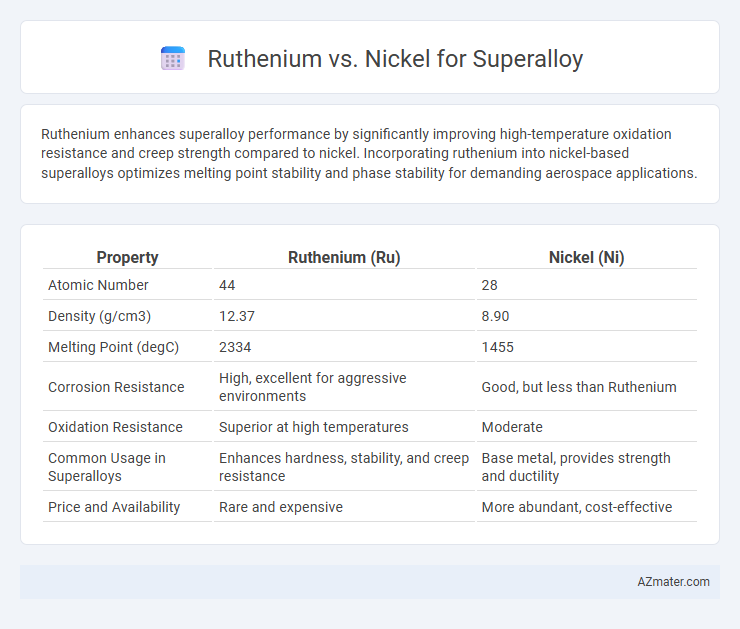Ruthenium enhances superalloy performance by significantly improving high-temperature oxidation resistance and creep strength compared to nickel. Incorporating ruthenium into nickel-based superalloys optimizes melting point stability and phase stability for demanding aerospace applications.
Table of Comparison
| Property | Ruthenium (Ru) | Nickel (Ni) |
|---|---|---|
| Atomic Number | 44 | 28 |
| Density (g/cm3) | 12.37 | 8.90 |
| Melting Point (degC) | 2334 | 1455 |
| Corrosion Resistance | High, excellent for aggressive environments | Good, but less than Ruthenium |
| Oxidation Resistance | Superior at high temperatures | Moderate |
| Common Usage in Superalloys | Enhances hardness, stability, and creep resistance | Base metal, provides strength and ductility |
| Price and Availability | Rare and expensive | More abundant, cost-effective |
Introduction to Superalloys: Importance and Applications
Superalloys are high-performance materials designed for extreme environments such as aerospace and power generation, where exceptional mechanical strength and resistance to oxidation and corrosion are critical. Ruthenium enhances superalloy properties by improving phase stability and creep resistance, while nickel serves as the primary base element known for excellent high-temperature strength and corrosion resistance. The balance between ruthenium and nickel content is crucial for optimizing superalloy performance in turbine blades, jet engines, and gas turbines.
Key Properties of Ruthenium and Nickel
Ruthenium enhances superalloy performance with exceptional high-temperature strength, oxidation resistance, and a stable microstructure due to its ability to slow gamma prime coarsening. Nickel, a primary base metal in superalloys, provides excellent corrosion resistance, toughness, and a strong face-centered cubic crystal structure that supports gamma prime strengthening. The addition of ruthenium to nickel-based superalloys significantly improves creep resistance and overall alloy stability under extreme operating conditions.
Role of Nickel in Superalloy Composition
Nickel serves as the primary matrix element in superalloys, providing exceptional high-temperature strength and corrosion resistance essential for turbine engines and aerospace applications. Its ability to form a stable face-centered cubic (FCC) structure allows for effective precipitation strengthening through elements like aluminum and titanium. While ruthenium enhances phase stability and reduces topological close-packed (TCP) phases, nickel fundamentally establishes the superalloy's mechanical and thermal performance.
Ruthenium as an Alloying Element: Unique Benefits
Ruthenium enhances superalloys by significantly improving phase stability and resistance to oxidation at high temperatures, outperforming nickel in these attributes. Its ability to reduce the formation of detrimental topologically close-packed (TCP) phases increases the alloy's mechanical strength and lifespan under extreme thermal conditions. Incorporating ruthenium as an alloying element optimizes the performance of superalloys used in aerospace and power generation turbines, where durability and thermal efficiency are critical.
Mechanical Strength: Ruthenium vs Nickel Alloys
Ruthenium-enhanced superalloys exhibit superior mechanical strength compared to traditional nickel-based alloys, primarily due to ruthenium's ability to improve phase stability and reduce elemental segregation during high-temperature exposure. Nickel alloys are widely used in superalloys for their excellent mechanical properties and corrosion resistance, but incorporating ruthenium can further enhance creep resistance and tensile strength under extreme operating conditions. The combination of ruthenium additions in nickel superalloys results in improved lattice stability and microstructural refinement, leading to enhanced mechanical performance in aerospace and power generation applications.
Corrosion and Oxidation Resistance Comparison
Ruthenium significantly enhances superalloy performance by improving oxidation resistance at high temperatures due to its ability to form stable, protective oxide layers. Nickel-based superalloys offer excellent corrosion resistance but can suffer from scale spallation and reduced lifespan under aggressive oxidative environments compared to ruthenium-containing alloys. Incorporating ruthenium increases resistance to hot corrosion and oxidation, making superalloys more durable in extreme aerospace and energy industry applications.
High-Temperature Performance and Stability
Ruthenium enhances the high-temperature performance and stability of superalloys by improving oxidation resistance and inhibiting phase instability at elevated temperatures, thereby extending service life in extreme environments. Nickel-based superalloys offer excellent mechanical strength and thermal stability due to their face-centered cubic (FCC) structure but are susceptible to oxidation and phase degradation beyond certain temperature thresholds. Incorporating ruthenium as an alloying element optimizes the microstructural stability and creep resistance of nickel-based superalloys, making it essential for aerospace and power generation applications operating at temperatures above 1000degC.
Cost and Availability: Ruthenium vs Nickel
Ruthenium is significantly more expensive and less abundant than nickel, making nickel a more cost-effective choice for superalloy production. Nickel is widely available as a base metal with established global supply chains, while ruthenium, a rare platinum group metal, faces limited availability and higher price volatility. The cost and accessibility of nickel make it the preferred element for superalloys in large-scale industrial applications.
Industry Applications: Aerospace, Energy, and Beyond
Ruthenium enhances superalloy performance in aerospace by improving oxidation resistance and mechanical strength at high temperatures, critical for turbine blades and jet engines. Nickel-based superalloys dominate energy sector applications due to their excellent creep resistance and corrosion durability in gas turbines and nuclear reactors. Beyond these industries, the combination of ruthenium and nickel in superalloys enables advanced manufacturing for chemical processing and automotive sectors requiring high-performance materials.
Future Trends in Superalloy Development
Ruthenium is gaining attention in superalloy development due to its exceptional oxidation resistance and ability to improve creep strength at high temperatures, outperforming traditional nickel-based alloys in extreme environments. Future trends emphasize ruthenium's role in enhancing thermal stability and extending component life in aerospace turbine engines, where temperature thresholds continue to rise. Research prioritizes optimizing ruthenium content to balance cost and performance, enabling next-generation superalloys with superior longevity and efficiency.

Infographic: Ruthenium vs Nickel for Superalloy
 azmater.com
azmater.com